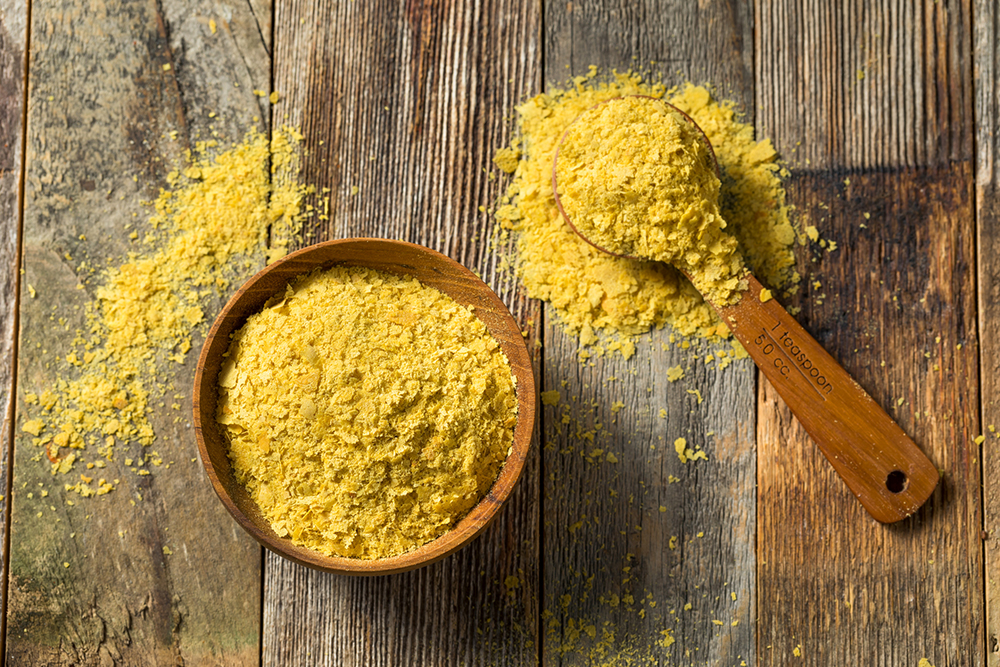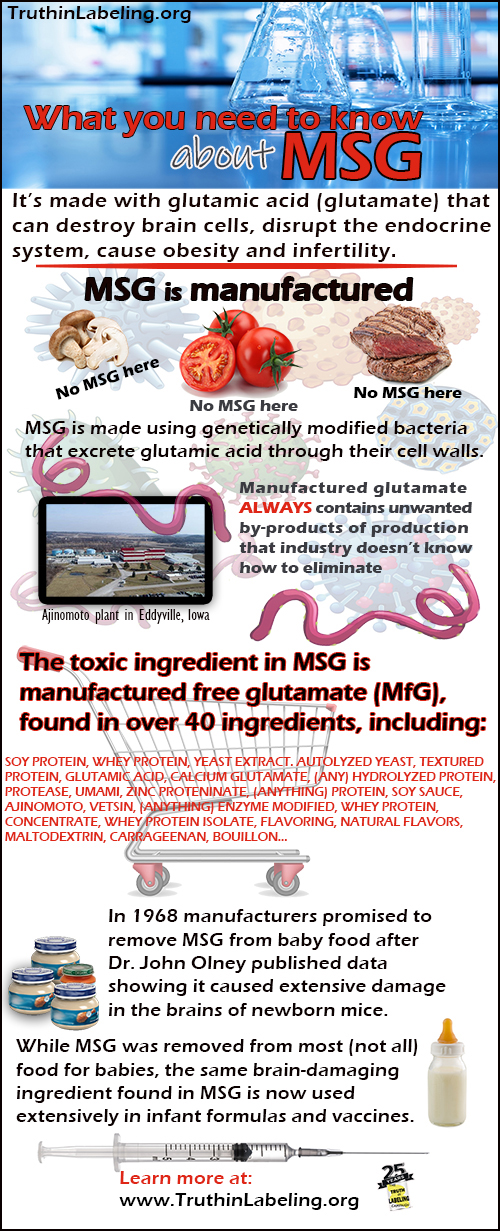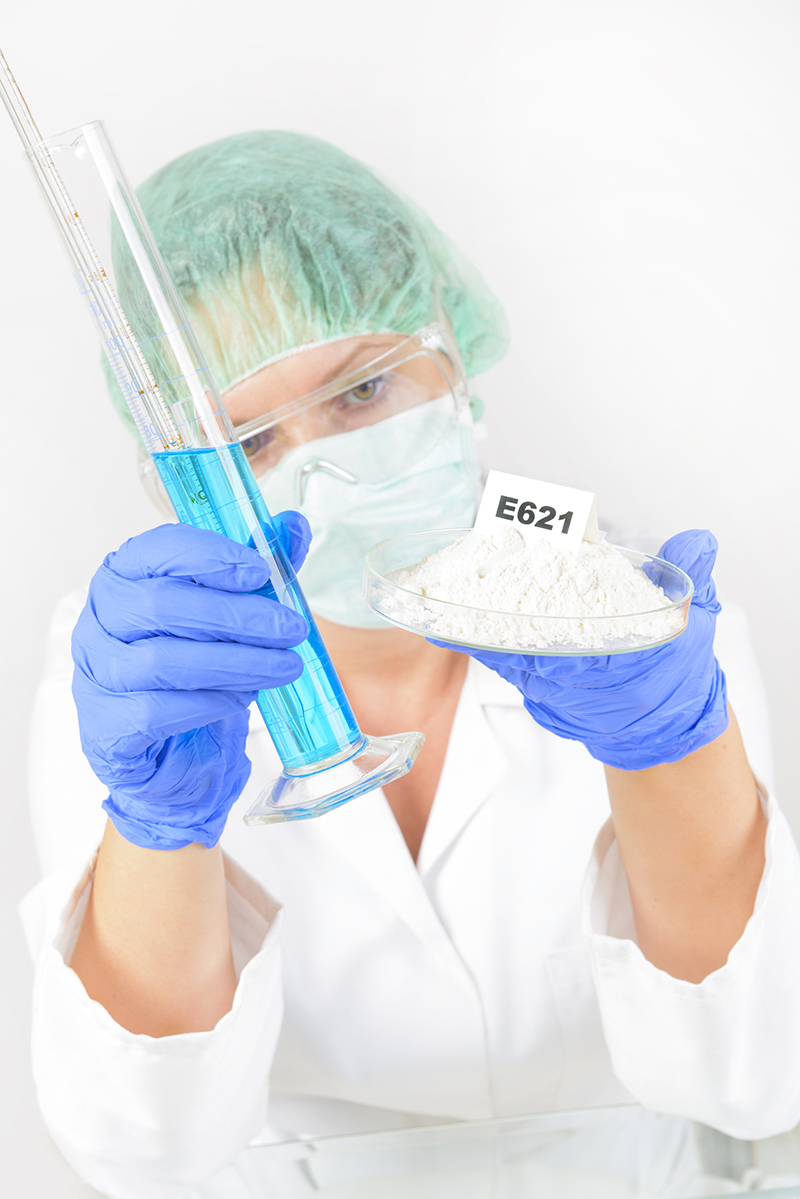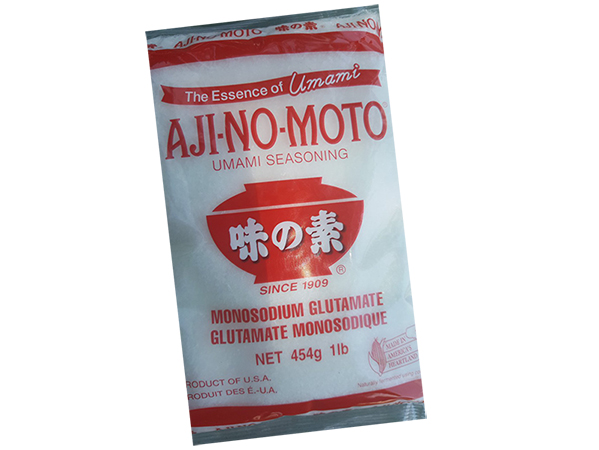Definition of terms:
Monosodium glutamate (MSG): A flavor enhancing ingredient used primarily in food.
MfG: Processed free glutamic acid – the neurotoxic component of monosodium glutamate and 40+ other ingredients.
What is monosodium glutamate?
Monosodium glutamate is a manufactured product, produced in food processing and/or chemical plants.
It is composed of L-glutamic acid (L-glutamate), D-glutamic acid (D-glutamate), additional impurities, and sodium.
The L-glutamate in monosodium glutamate is a patented product.
The commercial value of monosodium glutamate lies in its ability to stimulate (swell) glutamate receptors in the mouth and on the tongue—causing consumers to perceive more taste than the food being consumed would have if it had not been enhanced.
Monosodium glutamate contains:
- L-glutamic acid – its active ingredient,
- Impurities — unwanted, but unavoidable by-products of production: D-Glutamic acid – the D-enantiomer of glutamic acid; Pyroglutamic acid — a breakdown product of glutamic acid; assorted other by-products, and
- Sodium
What is glutamic acid?
Glutamic acid (often referred to as glutamate) is one of the many amino acids found in protein. When present in protein, it is tied to (bound to) other amino acids in chains.
Glutamic acid is found in most protein. Following ingestion of protein, and during the course of normal digestion, glutamic acid is released, becoming free glutamic acid.
If sufficient amounts of free glutamic acid are not available for normal body function, the body can create glutamic acid from other amino acids. Humans do not need to eat glutamic acid or eat protein that contains glutamic acid in order to supply the body with the glutamic acid that it needs. For that reason, glutamic acid is referred to as a “non essential” amino acid.
Glutamic acid has many faces.
First, and foremost, glutamic acid is a building block of protein. Amino acids are what proteins are made up of.
Second, glutamic acid is a neurotransmitter: a chemical agent that carries nerve impulses from one nerve to another. Neurotransmitters are the brain chemicals that move information, relaying signals between nerve cells, and from nerve cells to non-nerve cells. The brain uses neurotransmitters to tell your heart to beat, your lungs to breathe, and your stomach to digest. Neurotransmitters also affect mood, sleep, concentration and weight; and can cause adverse symptoms when out of balance.
Third, glutamic acid is an excitatory neurotransmitter. Neurotransmitters are either excitatory or inhibitory, and glutamic acid is excitatory — exciting the cells with which it communicates. Glutamic acid is the most common excitatory neurotransmitter in the central nervous system.
Fourth, glutamic acid is an excitotoxin, causing nerves to fire repeatedly, overstimulating receptor cells (both neurons and non-neurons) until receptor cells die. Glutamic acid functions as an excitotoxin when it over-stimulates brain cells, or cells outside of the central nervous system, to the point of killing them.
Glutamic acid has toxic potential
Excessive glutamate release within the body can lead to excitotoxicity, causing cell death resulting in seizures, for example. Excitotoxicity has been implicated in certain chronic diseases including ischemic stroke, epilepsy, amyotrophic lateral sclerosis, Alzheimer’s disease, Huntington disease, multiple sclerosis, schizophrenia, depression, obsessive-compulsive disorder (OCD), seizures, addiction, attention-deficit/hyperactivity disorder (ADHD), autism and Parkinson’s disease. Glutamate released within the body as in stroke kills cells but not necessarily brain cells.
Excessive glutamate ingested as a free amino acid (not bound with other amino acids in protein) can lead to excitotoxicity, causing brain damage and subsequent endocrine disorders and adverse reaction when passed to fetuses (the unborn) and/or infants by pregnant or lactating women. Similarly, any human or animal whose brain has been damaged, or whose blood brain barrier is undeveloped, aged, or vulnerable because of prior damage may suffer brain damage from ingestion of excessive amounts of glutamate.
Glutamic acid excitotoxicity is the process that underlies the damage done by monosodium glutamate.
What is L-glutamic acid?
Glutamic acid is one of some 20+ amino acids found in protein. Just as humans have two hands, glutamic acid has two enantiomers (chemically identical molecules with the L-enantiomer being the mirror image of the D-enantiomer). Although they appear to be identical twins these molecules are fundamentally different; for one molecule cannot be superimposed on its mirror image. One molecular twin cannot be substituted for the other because they are asymmetrical. The difference is comparable to asymmetry between your right and left hands. One is a mirror image of the other, but you cannot fit your right hand into a left-hand glove.
It is generally recognized that the free amino acids and proteins found in higher organisms are composed exclusively of the L-enantiomers of amino acids. The mirror image D-forms are only known to be present in some naturally occurring peptide antibiotics and in the cell walls of bacteria.
L-glutamic acid can be fabricated. In the beginning L-glutamic acid in monosodium glutamate was produced by extraction – extracting the glutamic acid from an intact protein source (milk or seaweed, for example). After 1957, however, the method of choice for producing monosodium glutamate changed. Today, most (if not all) monosodium glutamate production is based on the growth of a carefully selected strain of genetically modified bacteria that will excrete glutamic acid through their cell walls. Other methods used to fabricate L-glutamic acid make use of enzymes, autolysis, bacterial fermentation, acid hydrolysis of protein, and production of reaction flavors.
Impurities in L-glutamic acid and monosodium glutamate.
The essence of flavor-enhancing monosodium glutamate is its L-glutamic acid; for it is L-glutamic acid that stimulates the glutamate receptors in the mouth and on the tongue to give the consumer the perception of enhanced flavor in food being eaten. Specifically, it is the L-enantiomer (L-glutamic acid), not the D-enantiomer, that has flavor-enhancing potential. So anything other than the L-glutamic acid produced when monosodium glutamate is produced would appropriately be considered an unwanted by-product of monosodium glutamate production (an impurity).
Without exception, when monosodium glutamate is produced, impurities accompany manufacture. Industry has found no way of producing L-glutamic acid and monosodium glutamate without also producing impurities. Neither has industry found a way to remove impurities from manufactured L-glutamic acid and monosodium glutamate.
The subject of impurities in monosodium glutamate was elaborated in a Bulletin of the Japanese Central Customs Laboratory in 1977. (PDF file)
Regardless of how it is produced, be it by hydrolysis, enzymolysis, autolysis, fermentation, or other, impurities will always accompany production of L-glutamic acid, hydrolyzed protein products, autolyzed yeasts, maltodextrin, monosodium glutamate, and all the other products that contain processed free glutamic acid. The exact nature of the impurities will vary according to the source material used and the method(s) used in production.
D-glutamic acid is the second of the two molecules that make up glutamic acid.
As is true of all amino acids, the glutamic acid molecule is chiral, i.e., it is an object that is different from its reflection. At one time no thought was given to the possibility that there might be more than a structural difference, i.e. asymmetry, between chiral molecules. But over time, it was determined that the physiological properties of the two molecules also differ.
The case of thalidomide provides a perfect example. Thalidomide is a sedative drug that was prescribed for pregnant women from 1957 into the early 60s. When taken during the first trimester of pregnancy, thalidomide prevented the proper growth of the fetus, resulting in horrific birth defects in thousands of children around the world. The reason? The Thalidomide molecule is chiral, and the drug that was marketed was a 50/50 mixture of L-form and D-form. One of the molecules was a sedative, whereas the second one caused fetal abnormalities.
It may very well be that pyroglutamic acid holds the key to understanding glutamate toxicity. While there is no body of research focusing on the role of pyroglutamic acid in glutamate toxicity, there is research that speaks to pyroglutamic acid toxicity. There is also research that demonstrates that pyroglutamic acid can produce many of the same adverse events as produced by monosodium glutamate and the other ingredients that contain processed free glutamic acid. Add to that mix of information the facts that pyroglutamic acid can occur as a breakdown product of glutamic acid, and the fact that when L-glutamic acid is manufactured, pyroglutamic acid accompanies it as an unwanted by-product.
What evidence is there that monosodium glutamate has toxic potential?
It has been demonstrated repeatedly that it is processed (manufactured) free glutamic acid, i.e., L-glutamic acid plus impurities, that, when ingested, can cause brain damage, endocrine disorders (obesity and reproductive disorders) and adverse reactions such as asthma, heart irregularities, skin rash, and migraine headache. Glutamic acid bound in protein does not cause brain damage, endocrine disorders, or adverse reactions. When protein – whole protein — is ingested, that protein is digested, and the glutamic acid once bound up in that protein is released – without causing adverse events. It is only glutamic acid that has been freed from protein before it is ingested that causes adverse events.
Processed free glutamic acid causes adverse events regardless of the way in which it was processed or the ingredients in which it is found. The processed free glutamic acid in ingredients called “L-glutamic acid” and “hydrolyzed whey protein” will cause the same sorts of adverse events as those caused by the ingredient called “monosodium glutamate.”
Over the past 25 years, research has demonstrated that the role of sodium in monosodium glutamate does not impact monosodium glutamate’s toxic potential. It remains, therefore, that the manufactured free L-glutamic acid and/or its accompanying impurities are monosodium glutamate’s excitotoxins. The toxic component in monosodium glutamate is its processed (manufactured) free glutamic acid, which is always composed of L-glutamic acid, D-glutamic acid, pyroglutamic acid, and miscellaneous additional impurities.
Retinal degeneration
In 1957, Lucas and Newhouse first noticed that severe retinal lesions could be produced in suckling mice (and to some extent in adult mice) by a single injection of glutamate. Studies confirming their findings using neonatal rodents and adult rabbits followed shortly, with others being reported from time to time. In 2002, Ohguro et al. found that rats fed 10 grams of sodium glutamate (97.5% sodium glutamate and 2.5% sodium ribonucleotide) added to a 100 gram daily diet for as little as 3 months had a significant increase in amount of glutamic acid in vitreous, had damage to the retina, and had deficits in retinal function. Some time later, Ohguro et al. documented the cumulative effect of damage caused by daily ingestion of glutamate.
Early animal studies
In the late 60s, Olney became suspicious that obesity in mice, which had been observed after neonatal mice were treated with monosodium glutamate for purposes of inducing and studying retinal pathology, might be associated with hypothalamic lesions caused by monosodium glutamate treatment; and in 1969 he first reported that monosodium glutamate treatment did indeed cause brain lesions, particularly acute neuronal necrosis in several regions of the developing brain of neonatal mice, and acute lesions in the brains of adult mice. Research that followed confirmed that monosodium glutamate, which was routinely given as monosodium glutamate (brand name Accent), induces hypothalamic damage when given to immature animals after either subcutaneous or oral doses.
Human studies and reports of adverse reactions
What we know about monosodium glutamate toxicity and where it is hidden in food comes from discussions with researchers and food technologists; reading food encyclopedias, books, food company brochures, and published articles; attending food industry meetings; and from MSG-sensitive people and the health care professionals who work so valiantly to help them. In addition to research documenting adverse reactions to monosodium glutamate and the other ingredients that contain toxic processed free glutamic acid, there is evidence from consumers who report that their adverse reactions ameliorate/disappear when they clean all sources of processed free glutamic acid out of their diets.
The industry cover-up
Animal research: 1970-1980
When Olney and others demonstrated that monosodium glutamate causes brain lesions and causes neuroendocrine disorders in maturing animals fed monosodium glutamate as neonates and infants, glutamate industry researchers produced studies that they claimed were failed attempted replications; but their procedures were different enough to guarantee that toxic doses had not been administered, or that all evidence that nerve cells had died would be obscured. Industry-sponsored researchers said they were replicating studies, but did not do so. Instead, discussion was phrased to suggest that studies were “replications,” and the conclusions were based on what was said, not on the studies.
Examination of the methodology sections of representative studies by Newman, Reynolds, and Stegink will demonstrate that subjects, test materials, overall procedures, and/or methods of analysis differed from the studies being “replicated.” For example, although it had been established that brain lesions could not be identified if examination was not done within 24 hours after insult, glutamate-industry researchers routinely examined the brains of test animals after 24 hours had elapsed. They also used inappropriate methods and materials for staining the material they were examining.
Of particular interest were a study by Stegink et al. and a study by Reynolds, Butler, and Lemkey-Johnston. Careful examination will show that researchers used a single slide of the brain of one animal as evidence that free glutamic acid failed to produce brain damage in two different monkeys.
The work that demonstrates that glutamic acid causes brain lesions and neuroendocrine disorders in experimental animals has been replicated many times by independent neuroscientists – neuroscientists not funded by Ajinomoto and friends. In contrast, every published study sponsored by the glutamate industry has concluded that glutamic acid is “safe.” In 1981, Nemeroff, reviewing studies of the safety/toxicity of monosodium glutamate stated unequivocally that “…not one single [primate] study has truly replicated the methods utilized by Olney, making evaluation of the available [industry] data impossible.”
By 1980, researchers were using monosodium glutamate as an ablative tool with which to selectively kill brain cells in laboratory animals in order to develop drugs with which to counter the effects of glutamic acid in neurodegenerative disease. At that point, industry simply stopped talking about the safety of administering monosodium glutamate to laboratory animals.
Human research – the double-blind studies
In the 1980s, faced with overwhelming evidence that monosodium glutamate kills brain cells in laboratory animals, industry researchers changed their strategy. They began to claim that animal studies were not relevant to humans. They initiated a series of double-blind human studies that, they said, “proved” that monosodium glutamate was safe.
Detailed analysis of these double-blind studies revealed that subjects, materials used, and protocols for administering test and placebo material, minimized the chance that subjects would react to the monosodium glutamate test material; and that if subjects did react to the monosodium glutamate test material, they would also react to material that glutamate-industry researchers called “placebos.”
Industry researchers:
- Used variables and methods known to minimize or be irrelevant to identification of the toxic effects of glutamic acid; then concluded that glutamic acid never produces adverse effects. Studies focused on the relationship between “objective” parameters such as blood pressure and body temperature and ingestion of monosodium glutamate. But unless monosodium glutamate sensitive people are studied, one cannot legitimately draw conclusions about the relationship of the variables being studied (no matter how objective they are) to people who are sensitive to monosodium glutamate. Often, these studies were used to “prove” that people who are not sensitive to monosodium glutamate are not sensitive to monosodium glutamate.
- Limited the recorded adverse effects to a few generally mild and transitory reactions occurring simultaneously, such as those first reported in 1968 by Kwok and dubbed “Chinese-restaurant syndrome” (CRS): “…numbness at the back of the neck, gradually radiating to both arms and the back, general weakness and palpitation.” Industry researchers do not talk about migraine headache, asthma, tachycardia, arrhythmia, depression, anxiety attacks or other obviously debilitating and/or life-threatening reactions reported since 1968.
- Made no attempt during a study to prevent subjects from ingesting food to which they might be allergic or sensitive — thus increasing the chance that there might be MSG-reactions at times when placebo material had been given.
- Recorded reactions as reactions to monosodium glutamate or placebo material only if they occurred two hours or less following ingestion of test or placebo material, even though many symptoms are commonly expressed much later, and reactions may persist for much longer periods.
- Failed to report all data.
- Drew conclusions that did not follow from the results of the studies. International Glutamate Technical Committee (IGTC) researchers concluded, for example, that because approximately one third of their subjects reacted adversely to placebos containing aspartame or glutamate-containing ingredients other than monosodium glutamate, they had “proved” that reactions to monosodium glutamate-containing test material are not reactions to monosodium glutamate.
- Used test material that would minimize the adverse effects of glutamic acid test material. One gram monosodium glutamate encased in capsules, and therefore guaranteeing slow release, will cause less effect than 1gram monosodium glutamate sprinkled on food; and 1gram monosodium glutamate modified with sucrose will cause less effect than otherwise because sucrose is known to slow monosodium glutamate uptake.
- Continued subjects on medications that might block the effects of monosodium glutamate.
- Using placebos to which monosodium glutamate-sensitive people would react (placebos containing aspartame, carrageenan, enzymes, or some form of processed free glutamic acid found in ingredients other than monosodium glutamate, for example), researchers tested potential subjects for sensitivity to those placebos, and eliminate any subjects who reacted to them. Researchers could be fairly certain that those who did not react to their reactive placebos would not react to monosodium glutamate test material.
- Advertised for, and presumably used, “well subjects” – people who had never experienced any of the symptoms with which reactions to monosodium glutamate are associated. (If 50 per cent of the population were sensitive to monosodium glutamate, but research design precluded inclusion of that 50 per cent who were sensitive, a study claiming to assess the number of people sensitive to monosodium glutamate would be invalid.)
- Referred to studies as “randomized double-blind crossover design studies,” which gave the casual reader the impression that subjects were drawn randomly from the general population. In fact, subjects were often carefully selected people who would tell researchers that they had never experienced any of the adverse reactions associated with monosodium glutamate, and, under those conditions, were paid generously to participate in the studies. Other subjects were people, often students, paid for participating in industry-sponsored studies only if they said they were sensitive to monosodium glutamate. In either case, the only thing in those studies that was “random” was whether subjects get their monosodium glutamate test trial first and their placebo second, or vice versa. Subjects recruited in 1993 for a study begun in 1992 carried out at Harvard Medical School, Northwestern University Medical School, and UCLA Medical School, were paid hundreds of dollars each–only if the applying subjects (many of them students) claimed that they were sensitive to monosodium glutamate.
- Used placebos that were virtually guaranteed to produce as many reactions as might be produced following ingestion of the monosodium glutamate test material. Using toxic material in both test material and placebo, researchers argued that the reactions to monosodium glutamate-containing test material were not reactions to monosodium glutamate because subjects also reacted to placebos, which were assumed to be inert. Actually, the use of toxic material in placebos, particularly when it is identical or similar to the monosodium glutamate in the test material, makes it virtually inevitable that there will be approximately as many reactions to placebos as there are reactions to monosodium glutamate test material.
Sometimes glutamate-industry researchers use processed free glutamic acid in placebos, but use sources of processed free glutamic acid different than the ingredient called monosodium glutamate. Gelatin, which always contains free glutamic acid, has been a favorite.
Beginning in 1978, before aspartame was approved by the FDA for use in food, glutamate-industry researchers used aspartame in placebos. Over and above the fact that use of aspartame in placebos is grossly inappropriate, the fact that aspartame-containing products are supposed to carry a warning on their labels did not deter industry from using the substance, or the FDA from allowing its use. Aspartame contains phenylalanine (which adversely affects one in 15,000 Americans); aspartic acid (an excitatory amino acid); and a methyl esther. Aspartic acid and glutamic acid load on the same receptors in the brain, cause the same brain damage and neuroendocrine disorders in experimental animals, and, with the exception of blindness related to aspartame ingestion, cause virtually the same adverse reactions in humans.
There are over 7,000 unsolicited reports of adverse reactions to aspartame filed with the FDA. It should surprise no one, therefore, that glutamate industry researchers found as many reactions following ingestion of an aspartame-containing placebo as they found following ingestion of monosodium glutamate test material.
Placebo reactions have also been noted in industry-sponsored animal studies. In 1981, it was noted by Nemeroff that Abraham, Doughtery, Goldberg, and Coulston and Abraham, Swart, Goldberg, and Coulston found in both control and glutamic acid treated monkeys a “very small proportion of necrotic or damaged neuronal cells and oligodendrocytes… in the arcuate nuclear region of the hypothalamus.” This might happen if the placebo, as well as the test material, contained small amounts of an excitotoxin identical or similar to glutamic acid.
The bottom line
About taste…
In the first half of the 20th century, food encyclopedias (with articles often written by Ajinomoto, Co., Inc., which may very well be the world’s largest producer of monosodium glutamate) characterized monosodium glutamate as a “white, almost odorless, crystalline powder with a slightly sweet or salty taste. Each gram contains 5.5 meg of sodium. [Monosodium glutamate] is used as a flavor enhancer, imparting a meaty flavor, commonly in oriental foods.” Smolinske SC. Handbook of food, drug, and cosmetic excipients. Boca Raton: CRC Press, 1992
By the end of the 20th century, the mode of manufacturing monosodium glutamate had changed (a fact that has been only grudgingly publicly acknowledged by Ajinomoto), and Ajinomoto was laying the groundwork for proclaiming monosodium glutamate a fifth taste to stand side by side with sweet, salty, bitter, and sour.
It’s called Umami. It’s a fiction paid for by Ajinomoto to legitimize the use of monosodium glutamate in food. It’s the fifth taste that MSG-sensitive people can’t taste.
About the product…
Monosodium glutamate is a product that contains glutamic acid that has been freed from protein by a manufacturing process and/or through fermentation. In addition to glutamic acid, monosodium glutamate contains sodium. If follows, therefore, that monosodium glutamate is not found in protein. Protein is made up of an array of amino acids. There is no sodium in protein.
The glutamic acid portion of monosodium glutamate is made up of L-glutamic acid and D-glutamic acid. There is no D-glutamic acid in unadulterated protein.
Monosodium glutamate is a product, and, without exception, when monosodium glutamate is produced, unwanted by-products of manufacture accompany the manufacture. The subject was elaborated in a Bulletin of the Japanese Central Customs Laboratory in 1977 (PDF file).
The exact nature of by-products (impurities) will vary according to the source material used to produce the monosodium glutamate and the method used to produce it. There are no impurities associated with unprocessed, unadulterated, unfermented protein found in the human body or elsewhere.
By definition, L-glutamic acid from any source will be identical to L-glutamic acid from any other source. But monosodium glutamate contains impurities as well as L-glutamic acid. Truly natural, unprocessed, unadulterated, unfermented protein does not contain impurities.
There have been numerous patents awarded to those who would produce monosodium glutamate. Allowing patents to be awarded for processing monosodium glutamate testifies to the fact that the monosodium glutamate produced will not be truly natural, i.e., will not be an unmodified part of nature.
The rest of the story…
The rest of the story is told by the people who profit from sale of monosodium glutamate and the other ingredients that contain MfG. You will find their propaganda on the Internet (accessed 7/26/2016 and again on 1/12/2019):
The Glutamate Association
U.S. Food and Drug Administration (FDA) – Questions and Answers on MSG”
International Food Information Council (IFIC)
“The Fifth Taste: Discovering Umami”
“Monosodium Glutamate (MSG): From A to Umami”
“Glutamate and Monosodium Glutamate: Examining the Myths”
Umami Information Center (UIC)
International Glutamate Information Service (IGIS)
MSGDish Blog — a broad array of misinformation about umami, glutamate, and MSG
If you have questions or comments, we’d love to hear from you. If you have hints for others on how to avoid exposure to MfG, send them along, too, and we’ll put them up on Facebook. Or you can reach us at questionsaboutmsg@gmail.com and follow us on Twitter @truthlabeling.











